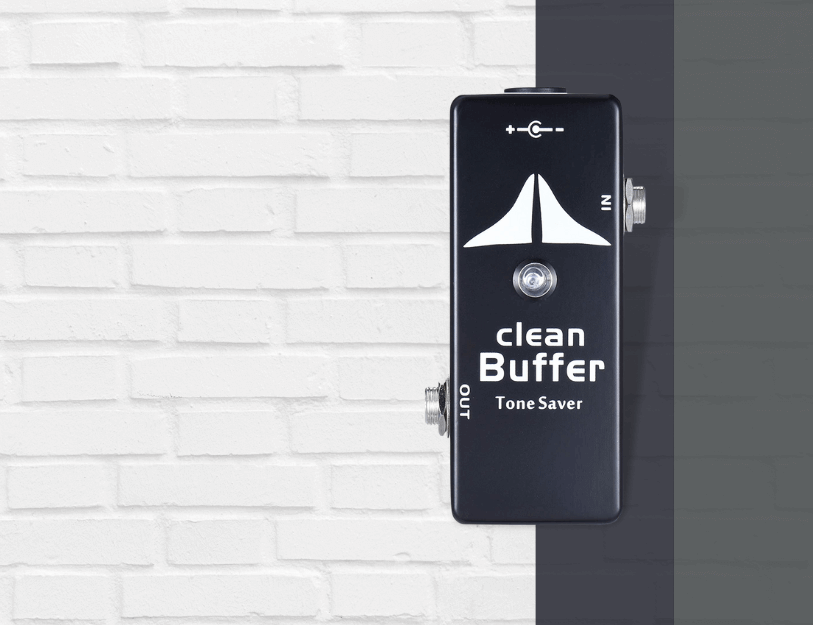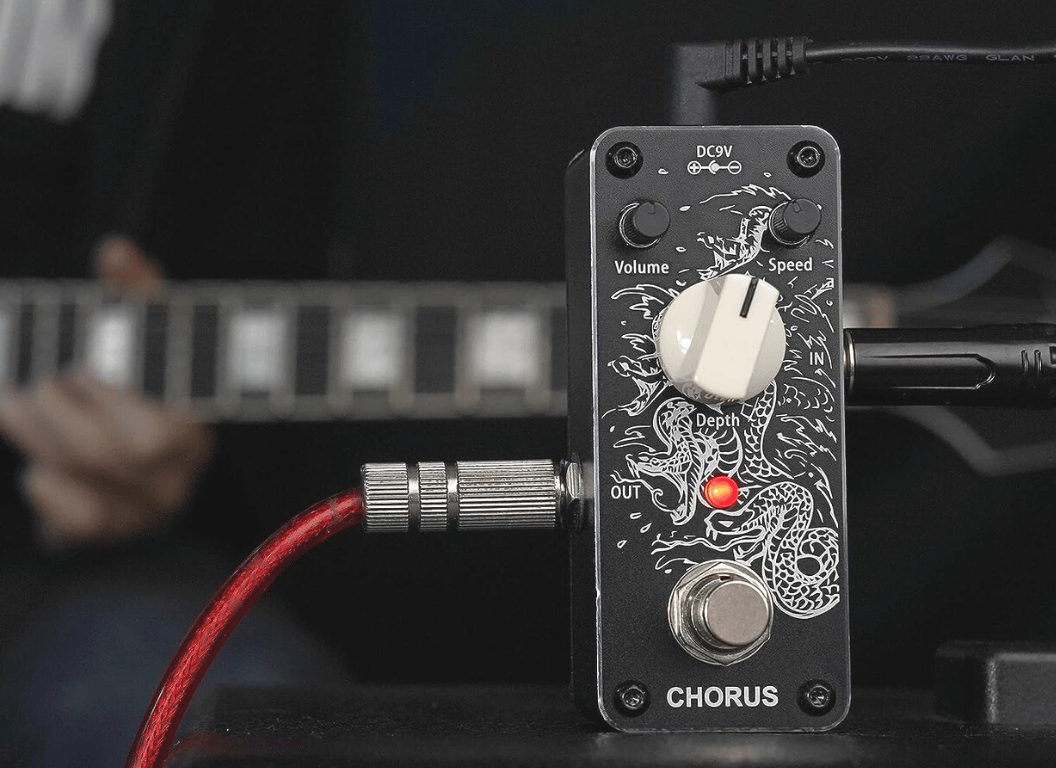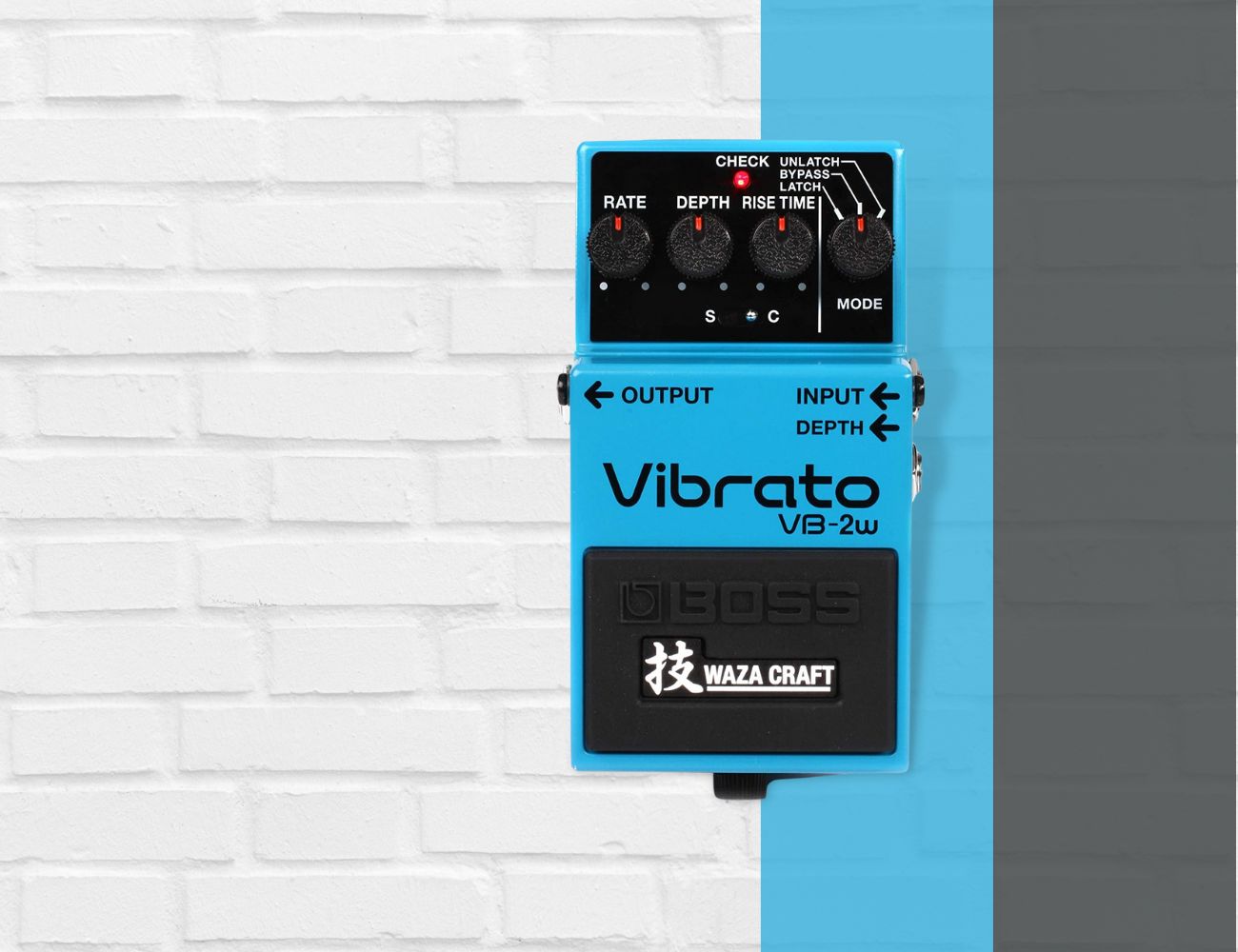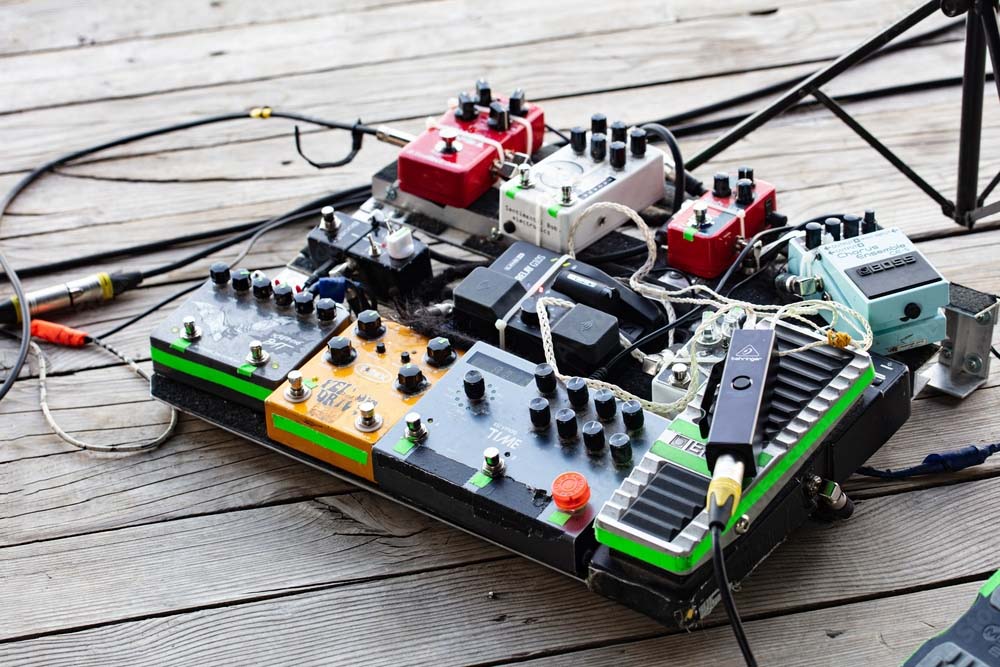If you’re serious about perfecting your guitar tone, you need to know the best buffer pedals out there.
Sound quality is vital to leave a lasting impression on your audience, and a top-notch buffer is key to maintaining a pristine signal throughout your pedal chain.
In this article, we’ll dive into buffer pedals, shedding light on how they work and why they’re essential for any guitarist aiming for an impeccable tone.
We’ll also guide you through our well-researched list of the best buffer pedals based on criteria like performance, durability, and price.
By the end, you’ll better understand what a buffer pedal means in the pedal world and how it can truly elevate your playing game.
Table of Contents
- Best Buffer Pedals
- What exactly is a buffer pedal?
- What to consider when choosing a buffer pedal?
- How to properly use a buffer pedal?
- – Familiarize yourself with the controls and features
- – Adjust the parameters to suit your musical goals
- – Incorporate the buffer pedal into your signal chain
- – Test the buffer pedal with your guitar and amp
- – Fine-tune the pedal settings based on your desired tone
- – Experiment with different playing techniques and effects for versatile usage
- – Regularly maintain your buffer pedal to ensure optimal performance
- How to order pedals on a pedalboard?
- Boutique vs. Mass-Produced pedals
- How much should you spend on a guitar pedal?
- Can you use a guitar pedal with a bass guitar?
- How to properly power your pedals?
Best Buffer Pedals
Before I begin, here are my top selected choices:
TC Electronic Bonafide Buffer Pedal

Maintains unaltered tone with automatic true bypass. Check Price
|
|
MOSKYAudio Mini Clean Buffer Pedal

Robust, natural guitar tone with no signal loss. Check Price
|
TC Electronic Bonafide Buffer Pedal
Maintains unaltered tone with automatic true bypass.
BONAFIDE BUFFER is a high-quality, ultra-compact analog buffer that preserves your tone from cable runs, featuring an automatic true bypass in case of power failure. Its 1M ohm input and 100 ohm output provide a transparent, crisp sound with no signal degradation.
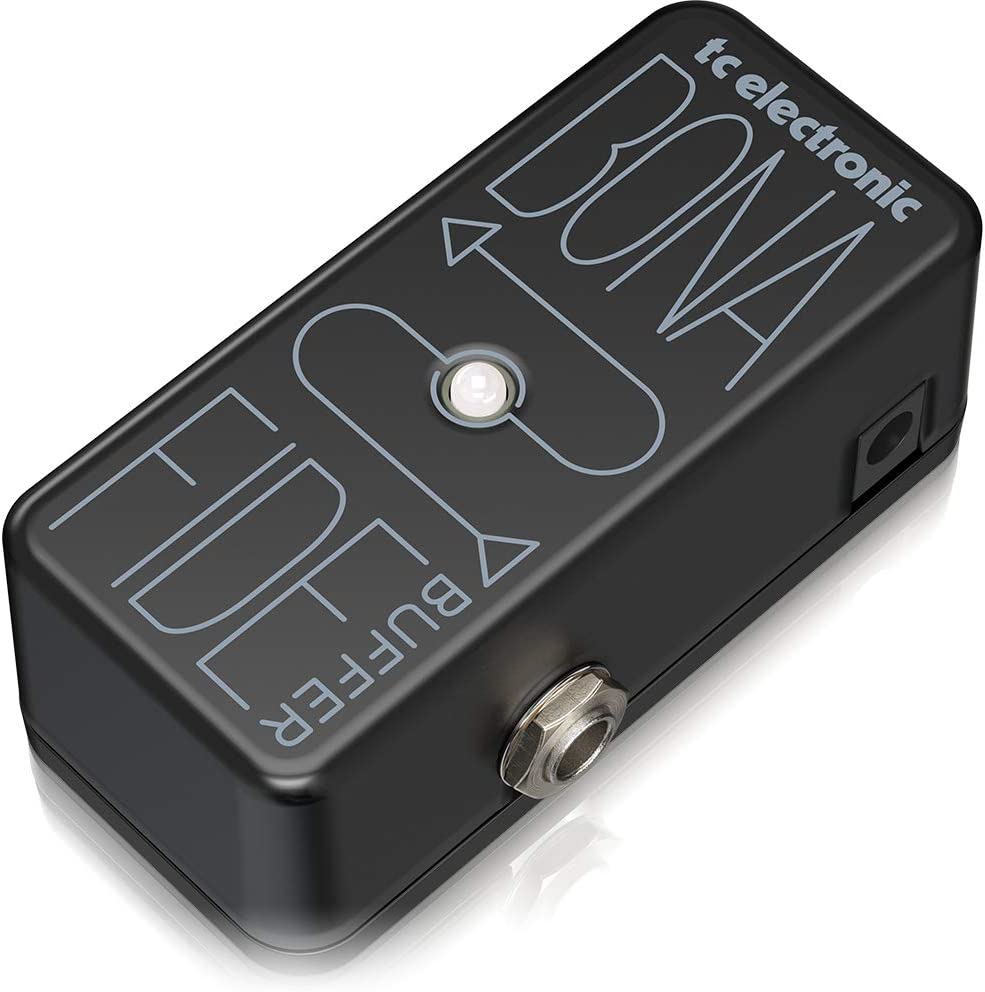
Meet the TC Electronic BONAFIDE BUFFER, an ultra-compact analog buffer to safeguard your precious guitar tone.
This tiny yet powerful tool allows you to run extended cables without worrying about any loss in signal quality.
One of its standout features is its automatic switch to true bypass in case of power failure, ensuring your tone is always heard.
Despite its small size, it boasts an impressive design that can fit under or on any board, optimizing space usage.
Produced by TC Electronic, this buffer is exceptionally light, weighing only 1 pound, and compact, with dimensions of 3x4x3 inches.
The unit operates at a voltage of 9, enabling it to perform efficiently.
Its main goal is to transform your guitar’s high-impedance output into low impedance, opening up a world of strong, free-flowing tonal possibilities.
It solves signal degradation caused by long cable runs and large pedal setups.
This is essentially a high-grade tone tool that goes a long way in refining your sound output.
- My Review
Taking the TC Electronic BONAFIDE BUFFER for a spin has been quite an experience.
This little box may seem like just another addition to your pedalboard, but it’s a secret weapon that keeps your tone vibrant and intact.
As someone who’s used to struggling with signal loss due to extensive cables and multiple pedals, finding a solution that’s this effective is a bit of a game-changer.
Cranking it up, I was impressed by the difference it made.
My sound was clearer and brighter, with a noticeable quality boost.
It does exactly what it’s intended for—preventing tone loss—and does it remarkably well.
No more muffled sounds or loss in definition when hitting those high notes.
The BONAFIDE BUFFER steps in and keeps everything in check.
I appreciated the thoughtful design element of an automatic switch to true bypass during a power failure.
You’d think this feature is common, but surprisingly, not all buffers have it.
It’s comforting to know your performance won’t be affected, no matter what.
Its compact design is another plus point when weighing just one pound.
Fitting it onto the pedalboard was a breeze—it takes up hardly any space.
Yet, despite its size, it delivers in a big way regarding performance.
Still, I wish they’d included a power supply with it.
Considering its price, that would’ve been a nice touch.
Despite this small downside, there’s no denying that the BONAFIDE BUFFER is a well-designed tool for any guitarist seeking to preserve their unique tone.
It’s a robust little device that packs a punch.
Here are the ratings I’ll give to the TC Electronic Bonafide Buffer Pedal:
Rest assured, it’s a worthwhile investment for your sound.
And in my experience, it’s certainly lived up to the hype.
- Pros:
- High-quality analog buffer.
- No signal degradation with long cables.
- Automatic True Bypass in power failure mode.
- Ultra-compact design fits on any board.
- Cons:
- Some users didn’t notice a significant difference.
- Harsh and unnatural tone for a few users.
- No twin outputs.
My final verdict is that the TC Electronic BONAFIDE BUFFER is a highly recommended product for guitarists looking to maintain their tone and overcome signal degradation caused by long cable runs.
Its high-quality analog buffer, automatic True Bypass feature, and compact design offer valuable benefits for preserving the integrity of your guitar sound.
The majority of positive reviews highlight its effectiveness in improving tone and its overall value for the price.
However, a few negative reviews mention a subtle difference in effect or personal preferences regarding the tone.
Considering its versatile features, solid performance, reputable brand, and overall positive feedback, the TC Electronic BONAFIDE BUFFER is a reliable choice for guitarists seeking to optimize their signal chain.
Fender Level Set Buffer Pedal
Stage-ready construction with trim controls, tuner output, and LED-illuminated knobs.
The Level Set Buffer is a buffer pedal designed to help you easily swap guitars and optimize your signal strength with level, hi-freq, and load controls. It also features a main mute footswitch and a separate tuner output for silent tuning. LED-illuminated knobs and a magnetic battery door make it stage ready.
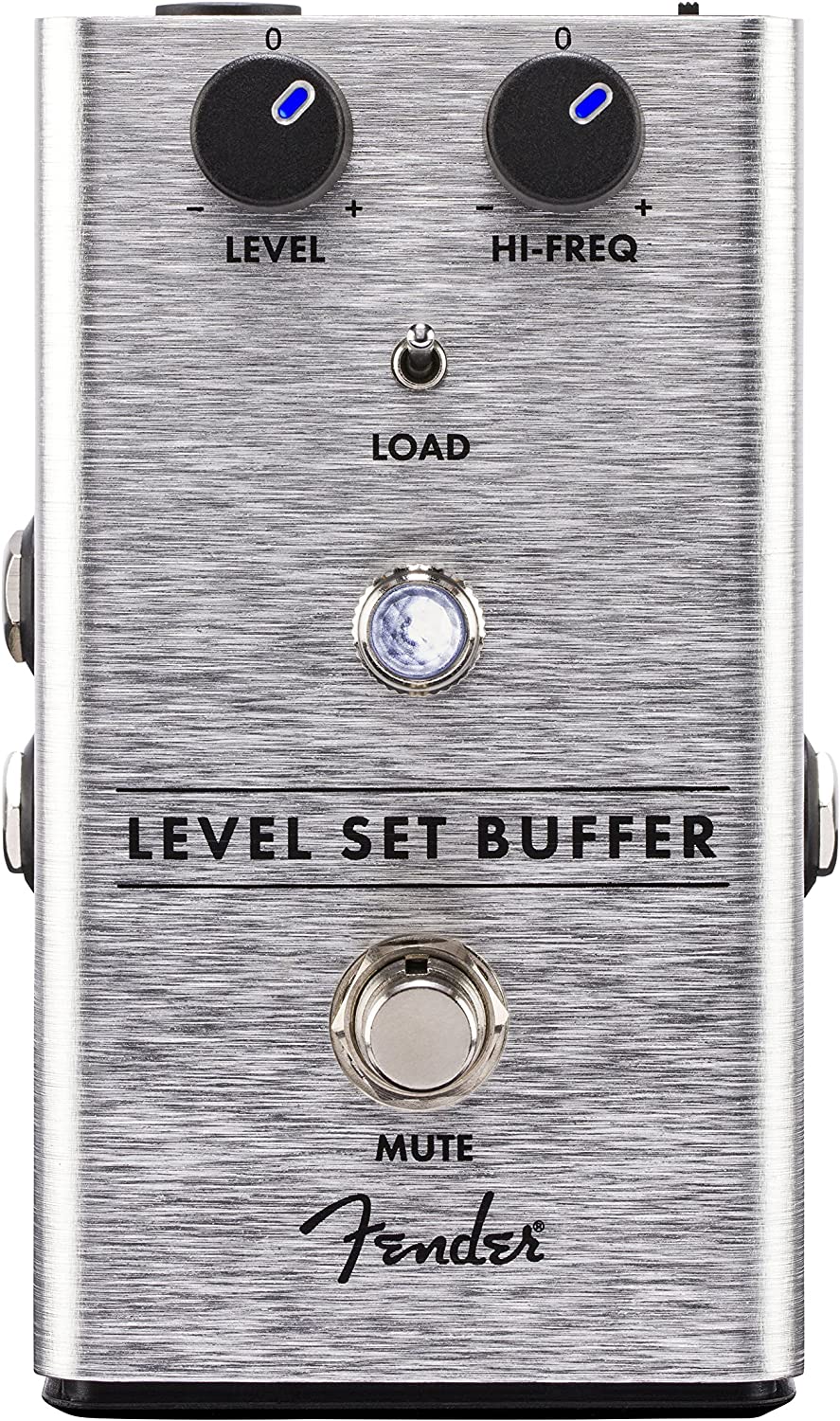
Looking at the Fender Level Set Buffer Pedal, its purpose is to alleviate potential issues that can occur when swapping between different guitars or using a complex pedal board.
It’s a handy tool that allows for smoother, more consistent tone, even when switching from a single-coil to a humbucking pickup.
Its features’ core are level, hi-freq, and load controls to adjust your signal.
Thanks to the main mute footswitch, it has a silent tuning feature, which is especially handy for live performances.
The separate tuner output ensures your tuner is always on without disrupting your signal path.
A special feature of this pedal is the LED backlit knobs.
They provide easy visibility of your settings, even in the darkest stages.
And if you’re worried about the hassle of changing batteries, Fender has covered you with a magnetically latched hinged 9V battery door.
This pedal is housed in durable anodized aluminum, ready to endure any touring rigors.
- My Review
I have to admit that I was pleasantly surprised by my experience with the Fender Level Set Buffer Pedal.
First, its purpose, which is to minimize those pesky tone inconsistencies when swapping between guitars or traversing a complex pedal board, is fulfilled quite effectively.
The adjustment controls for level, hi-freq, and load brought a new layer of precision to my tone-tweaking that I didn’t realize I was missing.
As I explored the functionality, the main mute footswitch quickly became a favorite feature of mine.
It offers silent tuning – a godsend during live performances.
Continuously active without signal disruption, the separate tuner output adds an extra convenience layer.
Now, let’s talk aesthetics and usability.
You might not think LED backlit knobs are essential until you find yourself on a dimly lit stage.
They’re a game-changer, offering easy visibility of settings.
However, I found the central LED too bright, even in daylight, which can be dazzling.
Battery replacement, often a hassle, was a breeze with the magnetically latched hinged 9V battery door.
It’s one of those small details that truly enhance the user experience.
Housed in durable anodized aluminum, this pedal feels ready to endure the rough and tumble of any touring rigors.
Yet, it wasn’t all roses.
At times, it was hard to discern the impact of the pedal on my sound.
I sometimes questioned its functionality – but this could be more about fine-tuning my understanding of its operation.
In all, the Fender Level Set Buffer Pedal proved to be a useful tool.
Here are the ratings I’ll give to the Fender Level Set Buffer Pedal:
It excelled in some areas leaving room for minor improvements.
To me, it’s a handy addition to any pedal board setup.
- Pros:
- Boosts tone and output for better sound.
- Allows easy swapping of guitars without tone loss.
- Includes level, hi-freq, and load controls.
- Tuner output keeps tuner active without signal degradation.
- LED-illuminated knobs for easy visibility on stage.
- Cons:
- Some users found it ineffective or malfunctioning.
- One user mentioned the LED brightness issue.
My final verdict is that the Fender Level Set Buffer Pedal is a highly versatile and feature-rich pedal with improved tone and performance.
Its level, hi-freq, and load controls allow easy guitar swapping without compromising your sound.
The tuner output and LED-illuminated knobs are valuable additions, enhancing usability on stage.
The brand reputation of Fender further adds to its appeal.
While a few negative reviews mentioned functionality issues and LED brightness, the overall positive feedback indicates that it is a valuable addition to a pedalboard.
Considering its features, performance, and brand value, it offers good value for guitarists seeking to optimize their signal strength and tone.
JHS Little Black Buffer Guitar Pedal
Restore clarity and tone with the Little Black Buffer.
The Little Black Buffer restores lost tone from long cable runs and pedal chains, giving you incredible clarity and output. Mount it on the underside of your pedalboard for easy access and improved pedalboard real estate.
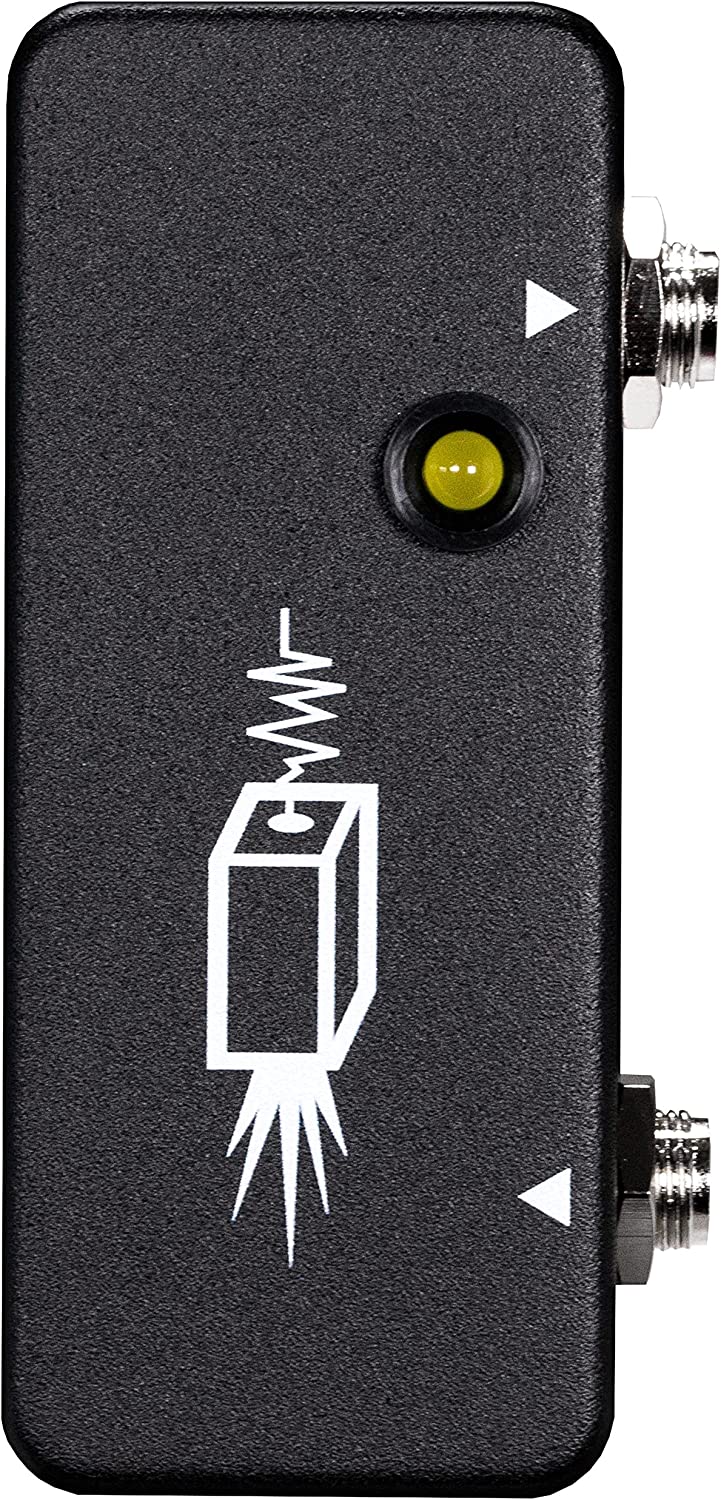
You might not notice it first, but the JHS Little Black Buffer Guitar Signal Buffer is a genuine game-changer for your pedalboard.
This low-key gear is designed to restore and maintain the integrity of your guitar’s tonal character, especially when dealing with elaborate pedal chains or lengthy cable runs.
Despite its simplicity, it plays a pivotal role in preventing tone loss, helping keep your guitar’s sound as original and vibrant as possible.
Moreover, it achieves this without interfering with your pedalboard setup – you can easily mount it under your board due to its low-profile design.
Converting your guitar’s hi Z signal to lo Z, it’s engineered to compensate for the tone loss from using long cables and several pedals.
Boasting a compact, robust build, it’s quite simple to integrate it into your rig.
The pedal’s black powder coating ensures it remains discreet in the background, contributing to the overall neatness of your setup.
Regarding its dimensions and weight, this little gear measures 6 x 3 x 3 inches and weighs less than half a pound, which makes it conveniently light and easy to fit into any pedalboard configuration.
The brand behind it is JHS Pedals, a renowned name in the industry known for its dedication to quality.
The style? As the name suggests, it’s a Little Black Buffer – powerful yet unassuming.
- My Review
My journey with the JHS Little Black Buffer Guitar Signal Buffer was transformative.
Initially, I perceived it as just another addition to my existing gear lineup.
However, it quickly became evident that this little black box had an enormous role.
Straight out of the box, its unassuming aesthetics struck me first.
Black, compact, and minimalistic – a design philosophy subtly tells you, “I’m here to do my job, not steal the show.” Its petite size meant it was a breeze to integrate into my existing setup, fitting snugly under the pedalboard, away from all the action yet very much part of it.
Turning it on was akin to removing a blanket from my guitar’s tone.
The effect was immediately noticeable – my sound was richer, more vibrant, more like the direct, unfiltered tone you’d get when plugging straight into an amp.
This little buffer preserved that original tone, preventing it from getting diluted in the sea of cables and pedals.
While it effectively converted my guitar’s high-impedance signal into a low-impedance one, what surprised me was how cleanly it did so.
The resulting tone was sharp, detailed, and, most importantly, unaltered.
That’s not something every buffer on the market can promise.
Yet, there’s room for improvement.
A major downside was its excessive LED brightness.
Seriously, it could double as a small flashlight.
Another minor hiccup I noticed was a lack of clear input/output labeling.
I found this slightly inconvenient, especially for a gear that pitches itself as user-friendly.
It took me a quick minute to figure it out.
Here are the ratings I’ll give to the JHS Little Black Buffer Guitar Pedal:
Despite these small inconveniences, I believe the JHS Little Black Buffer is a worthy investment for any guitarist looking to maintain the integrity of their tone.
It’s a simple solution to a complex problem, executed brilliantly.
- Pros:
- Restores high-end detail and tonal character.
- Compact, sturdy, and simple to integrate.
- Preserves the purity of your tone.
- Effective for long cables and pedal chains.
- Improves clarity and signal strength.
- Cons:
- No clear instructions or input marking.
- Possible DOA (Dead on Arrival) units.
- Some users didn’t notice a significant difference.
- Price may be considered relatively high.
- Bright LED light can be distracting.
My final verdict is that the JHS Little Black Buffer Guitar Signal Buffer is highly recommended for guitarists looking to restore high-end detail, preserve tone, and overcome signal loss caused by long cable runs and pedal chains.
Its compact design, sturdy construction, and integration simplicity offer versatility and compatibility with various pedal setups.
The brand’s reputation for quality adds to its appeal.
While some users experienced minor drawbacks like the lack of clear instructions and the possibility of receiving a defective unit, overall, the buffer delivers on its promises and provides a valuable solution.
Considering its effectiveness and improvements, the JHS Little Black Buffer is a worthwhile investment for those seeking to enhance their guitar’s tone and signal integrity.
MOSKYAudio Mini Clean Buffer Pedal
Robust, natural guitar tone with no signal loss.
This guitar effect pedal is made of zinc-aluminum alloy, powering up with DC 9V and providing 1/4″ Monaural Jack signal input and output. Battery power cannot be installed due to the shell material and volume. Easy to install and use.
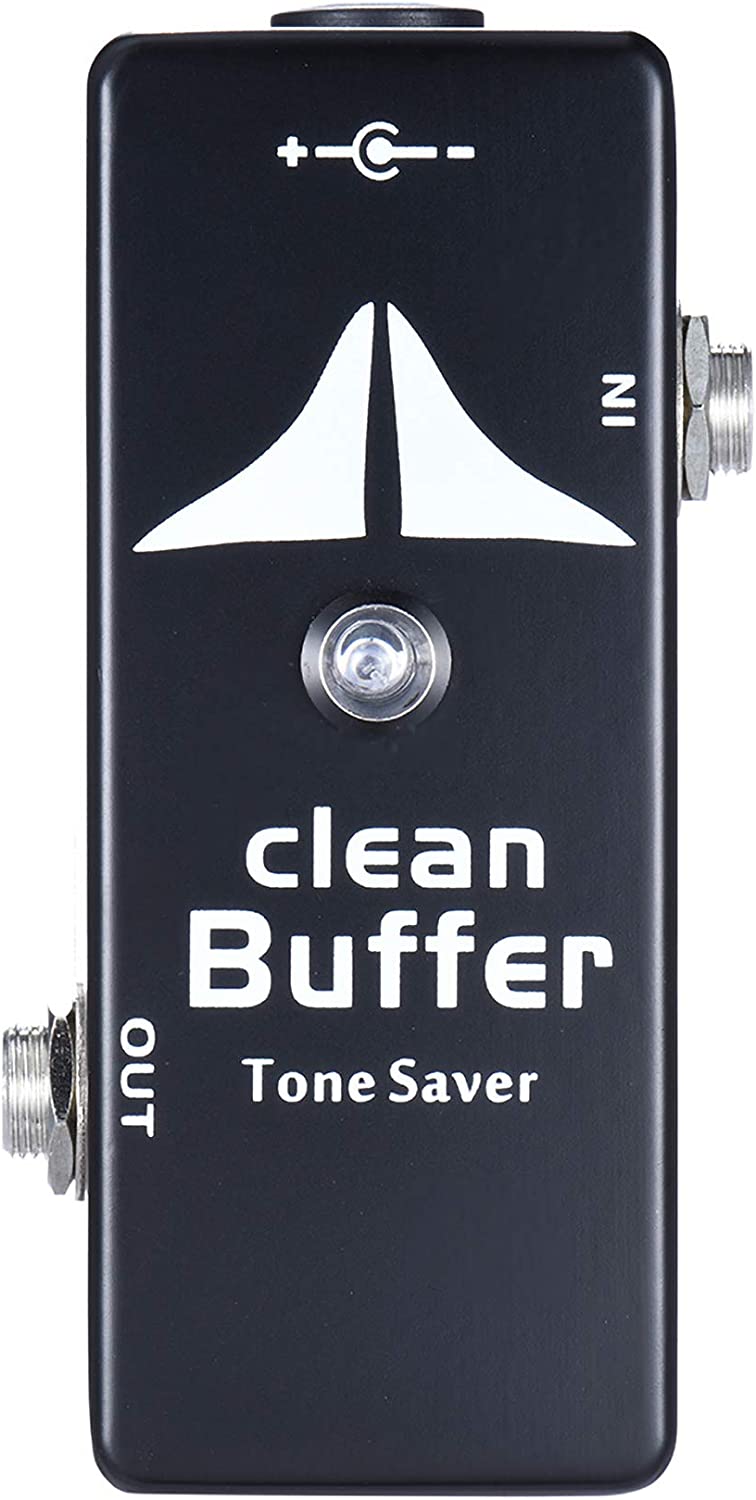
The MOSKYAudio Mini Clean Buffer Effect Pedal is a pocket-sized powerhouse tailored to the needs of guitar enthusiasts who use multiple pedals.
It restores your guitar’s sound that might otherwise weaken due to the overuse of pedals.
How does it work? It maintains your instrument’s natural, robust sound, almost as if you’re directly plugged into your amp.
The pedal smartly minimizes signal loss and effectively bolsters the tone.
It sports a simple, clean design with an LED indicator to show when it’s active.
A resilient body crafted from zinc-aluminum alloy ensures durability.
Furthermore, it’s a compact beauty, measuring just 3.5 x 1.4 x 1.2 inches.
Power-wise, it runs on 9 volts.
One thing to note, it doesn’t support battery power; it needs a DC power supply.
With a monaural jack for both input and output, it keeps your setup simple yet powerful.
- My Review
Let’s delve into the real meat and potatoes of the MOSKYAudio Mini Clean Buffer Pedal.
You might look at this compact, unassuming pedal and wonder, “What kind of difference can this make?” I’ll tell you, it’s more than meets the eye.
It’s small, but that doesn’t mean it lacks strength. It’s got a job, and it does it exceptionally well.
There’s something about plugging into your amp directly; that pure, unfiltered sound is unbeatable.
But we all know that isn’t always feasible, especially when an array of pedals is lined up.
So, here comes the MOSKYAudio Buffer to the rescue.
It truly acts as a bridge, restoring the strength of your guitar’s sound while working through all your favorite pedals.
It doesn’t color the sound, which I found impressive.
Instead, it preserves your instrument’s character, keeping the tones pure and crisp.
Now, let’s not gloss over this little guy being a fighter.
Its durable zinc-aluminum alloy body takes durability to a whole new level.
It’s not a battery guy; it prefers a steady DC power supply, a fair trade-off for the boost it gives to the sound.
Let me not forget to mention the LED indicator light – that little beacon is a sight for sore eyes when you’re lost in a sea of pedals.
A minor gripe, however, might be its sensitivity to power fluctuations.
It needs a regulated, clean power supply; otherwise, you could end up with a smoking pedal – and not in a good way!
So, make sure you’re prepped with a good power setup.
As far as guitar accessories go, this tiny titan is a marvel.
Here are the ratings I’ll give to the MOSKYAudio Mini Clean Buffer Pedal:
It slots in beautifully within your pedal chain, bringing something that makes all the difference.
Small, steady, and robust, it’s a secret weapon every guitarist should consider.
- Pros:
- Eliminates noise in guitar signal chain.
- Delivers robust, natural tone.
- Compact size and durable build.
- Transparent and compensates for signal chain losses.
- Fits nicely under pedalboards.
- Cons:
- Possible issues with power spikes.
- Noise interference in some setups.
- May not function as intended for some users.
My final verdict is that the MOSKYAudio Mini Clean Buffer Effect Pedal is generally a reliable and effective option for guitar players.
It offers the advantages of eliminating noise in the signal chain, delivering a robust and natural tone, and having a compact and durable design.
The positive reviews highlight its transparency and compensation for signal chain losses.
However, it’s important to note that a few critical reviews mentioned potential issues with power spikes and noise interference in specific setups.
These factors may affect its performance for some users.
Considering these factors alongside the overall positive feedback is recommended when making a decision.
Overall, the MOSKYAudio Mini Clean Buffer Effect Pedal provides good value for the price and can be a beneficial addition to a guitar setup, particularly for those dealing with weak guitar sound caused by using multiple pedals.
Fender Level Set Buffer Pedal
Lightweight, LED-illuminated knobs, silent tuning, and magnetically-latched battery door.
The Level Set Buffer provides convenient trim controls to use single-coil or humbucking pickups without changing your rig settings, a tuner output for silent tuning, and an LED-illuminated main mute footswitch. Its magnetic battery door and durable anodized aluminum construction make it ready for life on the road.
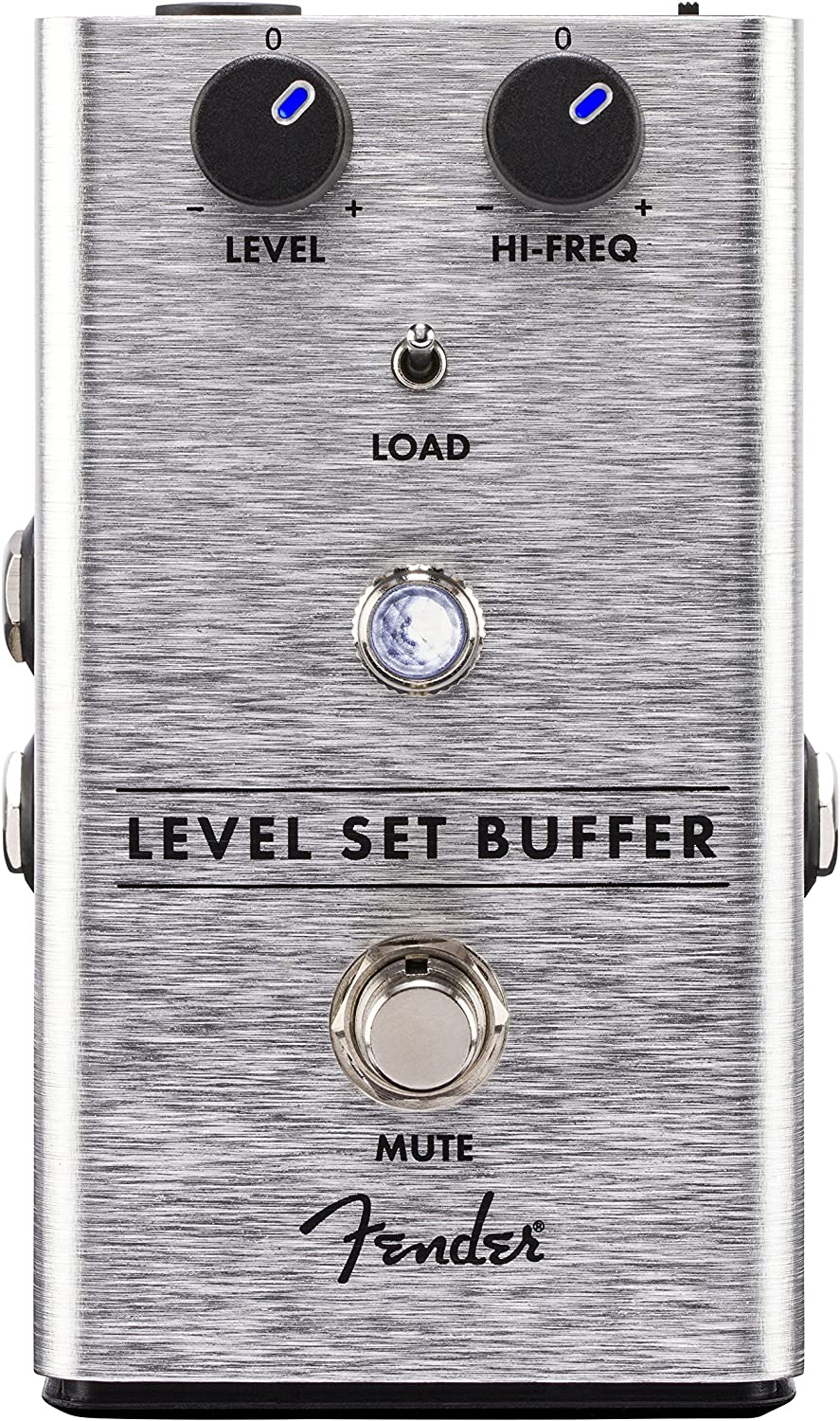
The Fender Level Set Buffer Pedal is a useful device to help guitarists maintain their tone quality when switching between guitars or using a complex pedal board.
This pedal effectively prevents signal loss due to cable capacitance and output variance from single-coil to humbucking pickups.
With its level, hi-freq, and load controls, you can easily adjust the signal to suit your needs.
At the same time, the main mute footswitch provides silent tuning capabilities for a better audience experience.
This buffer pedal is thoughtfully designed, featuring LED backlit knobs for easy visibility in dark environments and a magnetically latched battery door for quick and simple battery changes.
Constructed with lightweight, durable anodized aluminum, this pedal is built to withstand the demands of touring musicians.
The separate tuner output lets you stay active without disrupting your signal’s quality.
- My Review
I recently had the opportunity to try out the Fender Level Set Buffer Pedal, which genuinely impressed me in several ways.
The first thing I noticed was the high-grade anodized aluminum construction, which makes the pedal feel both lightweight and durable enough to handle the wear and tear of being on a pedal board.
Once I plugged in my different guitars and started playing with the Level Set Buffer, I could immediately notice a positive difference in my tone.
The pedal maintains the signal strength and tonal quality, allowing me to quickly switch between guitars with different pickup types without fiddle with amp settings or other gear.
It truly made swapping guitars more seamless than ever before.
The level, hi-freq, and load controls were particularly useful for tailoring the output to match the specific characteristics of my guitars.
Dialing in the right settings elevated the performance of each guitar, ensuring my sound remained consistent regardless of the instrument I was using.
Another extremely helpful feature was the main mute footswitch for silent tuning.
This allowed me to tune my guitars without causing any unwanted noise and spared my ears and audience during live shows.
The separate tuner output was also a game-changer, as it enabled me to keep my tuner active without affecting my tone.
One small critique I had was the brightness of the central LED light on the pedal.
It can be a bit overwhelming, even in well-lit environments.
However, this is easily remedied by covering the LED with a piece of tape to dim the intensity.
Here are the ratings I’ll give to the Fender Level Set Buffer Pedal:
In my experience, the Fender Level Set Buffer Pedal is a practical and efficient solution for guitarists seeking consistent tone and signal quality while working with multiple guitars or an extensive pedal board setup.
The pedal’s attention to detail and well-thought-out features make it a worthwhile addition to any guitarist’s collection.
- Pros:
- Maintains tone and signal quality.
- Versatile controls for diverse guitars.
- Separate tuner output for active tuning.
- Cons:
- Overly bright central LED light.
- Limited control options for advanced users.
- Price may be high for some budgets.
My final verdict is that the Fender Level Set Buffer Pedal is an excellent addition to any guitarist’s setup, regardless of their experience level or the intricacy of their pedal board.
Its blend of versatile controls, consistent tone improvement, and thoughtful design elements make it a smart investment for those seeking to enhance the versatility of their gear and maintain the quality of their sound.
JOYO D57 Buffer Effect Pedal
JOYO’s high-end buffer pedal combines buffer & boost for a pristine tone.
JOYO provides high-quality digital products for guitarists and music lovers, featuring innovative acoustic core technology and utility patents for an enhanced performance. Their products are favored by many musicians worldwide and come with a variety of power supplies for sale.
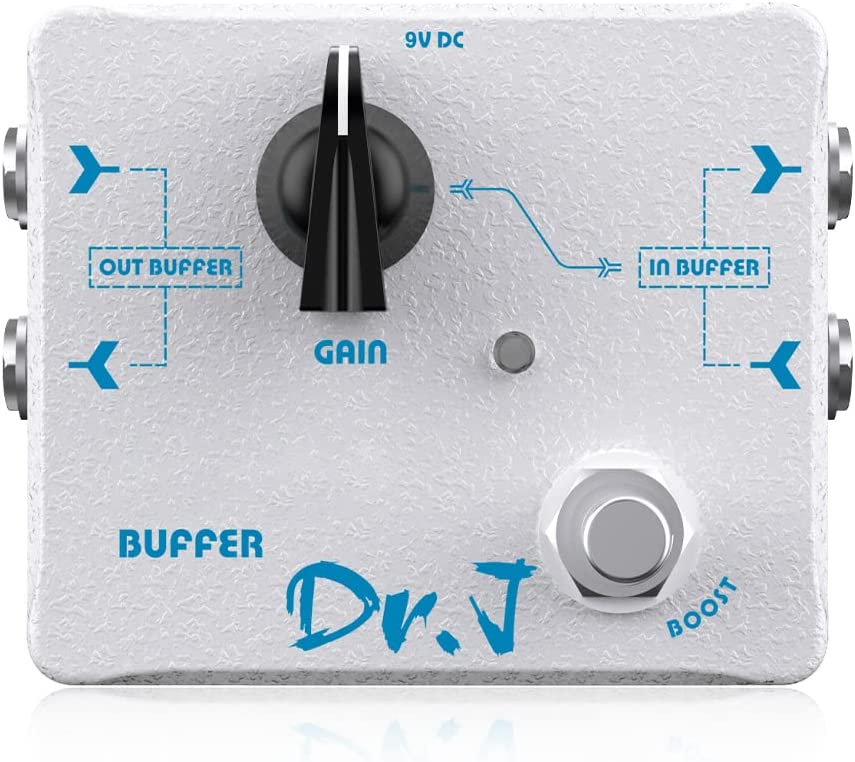
The JOYO D57 Buffer Pedal Effect is an advanced tool to provide the best experience for electric guitar or bass players.
Its main purpose is to reduce the tone and dynamic loss often associated with long cables, multiple FX pedals, or true bypass connections.
The pedal features two built-in buffer groups – the In Buffer ensures an effective and close connection between your guitar and the effect chain.
At the same time, the Out Buffer connects the effect chain and amp system to deliver your output signal effectively.
This high-end edition pedal also includes a footswitch-controlled boost and offers a 20dB gain range, making it a reliable solution for preserving your tone.
With its solid construction, paint spraying technology, and true bypass design, the pedal promises minimal tone loss and long-lasting durability.
To further enhance its appeal, the pedal comes in a stylish buffer white color and has dimensions of 4.02 x 3.15 x 2.28 inches, weighing 270 grams.
The JOYO brand is renowned for digital products in music education and provides a range of effects pedals, guitar amplifiers, and other accessories to meet the needs of guitarists worldwide.
- My Review
Upon trying out the JOYO D57 Buffer Pedal Effect, I found it a highly functional and versatile addition to my electric guitar setup.
The pedal is designed with two built-in buffer groups, effectively reducing tone and dynamic loss that often occurs when using long cables, multiple FX pedals, or true bypass connections.
Seeing that my signal quality was preserved, regardless of the connections involved, was great.
The solid construction of the D57, featuring paint spraying technology on the surface, added a sense of elegance while ensuring the pedal remains durable for long-term use.
Moreover, the true bypass design minimized tone loss, demonstrating that this pedal focuses on maintaining my guitar’s authentic sound.
One feature that stood out to me was the additional boost controlled by a footswitch, which offered a 20dB gain range.
This proved valuable when I needed that extra volume or wanted to enhance my guitar’s presence.
Using the pedal was a seamless experience, thanks to its straightforward controls and user-friendly design.
However, one drawback I found was the lack of a power supply in the package.
While it wasn’t a deal-breaker, it would have been convenient, especially for those starting their guitar journey who may not have a spare power supply.
I did notice a slightly high-pitched tone when the pedal was in use, although it wasn’t very prominent when playing.
While it didn’t deter me from using the pedal during practice, it’s something to consider for live performances.
Here are the ratings I’ll give to the JOYO D57 Buffer Effect Pedal:
In my experience with the JOYO D57 Buffer Pedal, I genuinely appreciated its functionality and adaptability, contributing to a richer, more polished sound for my electric guitar.
Despite minor drawbacks, this pedal has proven to be a valuable addition to my music toolkit.
- Pros:
- Effective tone and dynamic loss reduction.
- Additional 20dB boost with footswitch.
- Solid, durable construction.
- Cons:
- No power supply included.
- Slight high-pitched tone present.
- Limited versatility for live performances.
My final verdict is that the JOYO D57 Buffer Pedal is a valuable addition to any electric guitar or bass setup, offering effective tone preservation, a useful boost function, and solid construction.
Despite minor drawbacks, it delivers good overall performance and value for the price.
Empress Buffer Plus & Boost Pedal
All-analog signal path with noise filters, switchable boost and more.
Empress Effects Buffer+ is an all-analog signal path pedal designed to be the ultimate I/O interface for pedal boards. It offers powerful features such as noise filters, switchable clean boost, input pad, and input loading to optimize your guitar’s signal.
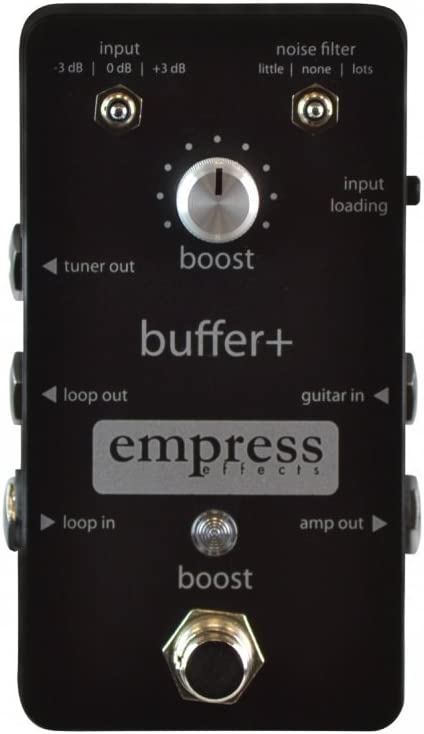
The Empress Buffer Plus w/Boost is an innovative effects pedal created by Empress Effects, specifically designed for use with electric guitars.
This compact, all-analog pedal aims to maintain the highest possible audio quality by offering a complete input/output interface for your pedal board.
Featuring a unique set of tools, such as noise filters, input pads, and switchable clean boost, the Buffer Plus is your one-stop solution for intensifying and refining your guitar’s sound.
Weighing in at only 0.66 pounds, this lightweight pedal is easy to carry and saves valuable space on your board.
Moreover, it has a built-in tuner output, allowing an easy connection to your favorite tuning device.
The Empress Buffer Plus w/Boost is a powerful tool for enhancing your guitar’s tonal clarity and boosting its presence in the mix.
- My Review
As someone who has tried out the Empress Buffer Plus w/Boost, I can vouch for its overall effectiveness in revolutionizing how your electric guitar’s signal is processed.
The compact, lightweight design of the pedal is truly convenient, and it effortlessly fits in alongside the other pedals on my board.
One of the standout features of this pedal is its all-analog signal path, which contributes greatly to retaining the purest audio quality possible.
I noticed a significant increase in the clarity and strength of my guitar’s tone when using it.
The noise filter function is also a fantastic addition to this pedal, as it efficiently suppresses any unwanted background noise throughout the performance.
The built-in tuner output and tuner mute are handy, as they make tuning a breeze while keeping my effects chain clean and uninterrupted.
Adjusting settings like input pads, switchable clean boost, and input loading turned out to be extremely user-friendly, with the overall interface leaving a feeling of simplicity and ease of use.
Speaking of the boost, I must say it did add an extra dimension to my sound.
The boost is designed to be placed at the end of your effects chain, which might raise some eyebrows, but it didn’t bother me since my existing setup was compatible with it.
However, one tiny aspect that could be improved is the layout of the 1/4-inch power input connections.
They seem a bit cramped on the pedal, but it’s a minor inconvenience that can be managed.
Here are the ratings I’ll give to the Empress Buffer Plus & Boost Pedal:
Based on my experience with the Empress Buffer Plus w/Boost, I am confident in its ability to enhance the tonal qualities of your guitar and provide great versatility in managing your guitar’s signal.
This pedal is worth considering for anyone looking to improve their guitar rig and achieve the perfect tone, dynamics, and signal strength blend.
- Pros:
- All-analog signal path.
- Compact, lightweight design.
- Enhances tone clarity and strength.
- Cons:
- Cramped 1/4-inch and power inputs.
- Boost at end of effects chain.
- No other cons identified.
My final verdict is that the Empress Buffer Plus w/Boost is a highly effective and versatile pedal with great features, tone enhancement, and performance, making it a valuable addition to any guitarist’s setup.
Despite some minor drawbacks in design, it delivers undeniable benefits while staying true to its brand reputation for quality.
What exactly is a buffer pedal?
A buffer pedal is a type of effect pedal used by guitarists and other musicians to maintain the integrity of their instrument’s audio signal as it passes through the signal chain.
As the name suggests, a buffer pedal’s main function is to act as a “buffer” between the instrument and the effects pedals, amplifiers, and other gear that might be part of a musician’s setup.
With the help of a buffer pedal, the musician can ensure that their instrument’s audio signal remains strong and clear, even as it travels through long cable runs and multiple effects pedals.

To understand what a buffer pedal does, it’s essential first to recognize the problem that it solves: signal degradation.
When an electric guitar, bass, or other instrument is plugged into an amplifier or an effects pedal, the audio signal is transmitted as an electrical current through a cable.
However, the natural capacitance and resistance present in the cable can cause the signal to lose its strength and clarity as it travels through the cable.
This results in a loss of high-frequency content, also called “tone-suck,” which can make the instrument sound dull and lifeless.
Likewise, when the signal passes through multiple effects pedals and connections, the cumulative resistance and capacitance from each additional pedal and cable further weaken the signal, resulting in even more pronounced tone loss.
This is where a buffer pedal comes into play.
A buffer pedal is an active electronic device designed to minimize the effects of capacitance and resistance introduced by long cable runs and multiple effects pedals.
When an instrument is connected to a buffer pedal, the buffer effectively boosts the signal’s strength by increasing impedance (or electrical resistance in terms of the flow of alternating current), allowing the audio signal to travel through the cable without suffering significant loss of high-end frequencies or clarity.
In other words, a buffer pedal ensures that the instrument’s original tone is preserved throughout the signal chain.
Buffer pedals can come in various designs and forms; however, their primary function remains the same.
Some buffer pedals are designed as standalone units, while others are built into certain effects pedals or the guitar or bass.
In some cases, a buffer pedal might also include additional features, such as a gain control to boost the overall signal level or tone-shaping controls to help shape the frequency response of the buffered signal.
When considering whether or not to use a buffer pedal, it’s important to consider the overall complexity of a musician’s signal chain.
If a guitarist uses only a few effects pedals and short cable runs, they might not experience any noticeable signal degradation and thus may not require a buffer pedal.
However, for musicians who utilize an extensive array of effects pedals or long cable runs, a buffer pedal can be particularly beneficial in preserving the instrument’s tone and eliminating any potential signal loss.
Effect pedals are generally divided into two categories: true bypass and buffered.
True bypass pedals are designed so that when the pedal is switched off, the audio signal bypasses the pedal’s circuitry completely and remains unaffected.
In contrast, buffered pedals maintain a constant connection to the pedal’s circuitry, which can introduce some capacitance and resistance even when the pedal is in bypass mode.
It may be tempting for a guitarist to assume that only using true bypass pedals can avoid potential tone loss without needing a buffer pedal.
However, while using true bypass pedals can help minimize some signal degradation, there is still the matter of the capacitance and resistance added by the cables themselves in the signal chain.
In this case, using a buffer pedal can still be beneficial in maintaining signal integrity.
Remember that even true bypass pedals may subtly change the signal’s tone when turned off.
This makes it essential to evaluate the effect each pedal has on your overall tone, whether true bypass or buffered bypass.
What to consider when choosing a buffer pedal?
When choosing a buffer pedal, you should consider numerous factors to ensure you make the best choice for your needs.
This process involves examining aspects such as:
– Sound quality:
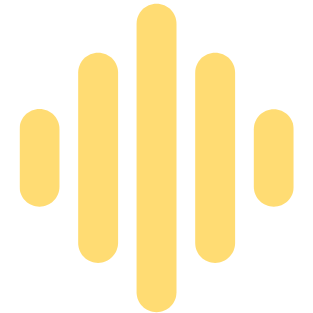
The primary reason for using a buffer pedal in the first place is to maintain the integrity of your guitar signal, especially when utilizing long cable runs or multiple effects pedals.
To achieve this, the buffer pedal should have a good signal-to-noise ratio and provide a clean, transparent signal without any coloration or distortion.
When considering a buffer pedal, ensuring that the sound quality lives up to your expectations and doesn’t negatively impact your overall tonal quality is essential.
So, when choosing a buffer pedal, carefully look into the specifications and features that are the most relevant to preserving the signal as accurately as possible.
– Controls and features:

A buffer pedal’s controls and features can significantly impact your experience, as different types of pedals offer various features such as true bypass, input and output impedance settings, and unity gain.
Some buffer pedals even come equipped with additional functions like a boost or EQ to provide even more versatility in fine-tuning your tone.
When making your decision, consider whether you need these extra features or prefer a simple, straightforward buffer pedal.
Comprehensive controls and features are essential when evaluating multiple buffer pedals, as they can directly affect the utility and applicability of the buffer.
Buffer pedals with user-friendly controls and features will improve your overall experience, especially during live performances or quick session changes.
– Analog vs. Digital

When comparing buffer pedals, you must decide whether you prefer an analog or digital pedal.
Analog buffer pedals tend to have a warmer, more “natural” sound and can often provide a more accurate representation of your original signal.
Digital buffer pedals can offer more features and processing power, but they may color your sound slightly, which may not be suitable for purists.

In weighing your preferences, consider the type of guitar rig and other effects pedals you’re using to ensure the buffer pedal you choose provides optimal integration and compatibility.
A strong and well-known brand reputation is crucial, as it is often a reliable indicator of the quality of products and the level of customer support.
This is especially important when choosing a buffer pedal for your guitar setup, as you want to make sure you are investing in a device that can deliver exceptional performance and lasting durability.
By considering the brand’s reputation and taking the time to research its other products, you can make a more informed decision as to whether or not its buffer pedal will provide the quality you seek.
Trusted brands are known to have dedicated extensive time and resources to refining their designs and ensuring that their customers are satisfied with their purchases.
This level of commitment to excellence also extends to their buffer pedals.
In addition to producing high-quality products, reputable brands tend to have more robust customer support services, offering assistance and resources that will help you make the most out of your purchase.
Whether you need technical support, troubleshooting assistance, or guidance on using your new buffer pedal to its fullest potential, a reputable brand will likely provide the help you need to have a seamless experience.
Choosing a brand with a positive reputation not only increases your chances of purchasing a reliable and effective buffer pedal but also ensures that you have access to the post-purchase support you may require.
– Presets and versatility

Buffer pedals with preset options offer enhanced versatility, allowing you to save different settings tailored to various guitars, amps, or other effects pedals.
This adaptability ensures optimal sound quality across diverse setups, making it an essential tool for musicians.
Furthermore, having access to presets and quickly changing settings on the fly can save considerable time and frustration.
This feature is particularly useful in live situations where swift adjustments are crucial to delivering a seamless performance.
However, musicians must consider their specific needs when selecting a buffer pedal.
If versatility and presets are not critical to your setup, a simpler, single-purpose buffer may suit you.
Ultimately, the right choice will balance functionality and simplicity, ensuring that your buffer pedal serves its purpose without overcomplicating your rig.
– Brand reputation

A strong and well-known brand reputation is crucial, as it is often a reliable indicator of product quality and customer support.
This is especially important when choosing a buffer pedal for your guitar setup, as you want to ensure you are investing in a device that delivers exceptional performance and lasting durability.
By considering the brand’s reputation and taking the time to research its other products, you can make a more informed decision as to whether or not its buffer pedal will provide the quality you seek.
Trusted brands are known to have dedicated extensive time and resources to refining their designs and ensuring that their customers are satisfied with their purchases.
This level of commitment to excellence also extends to their buffer pedals.

In addition to producing high-quality products, reputable brands tend to have more robust customer support services, offering assistance and resources that will help you make the most out of your purchase.
Whether you need technical support, troubleshooting assistance, or guidance on using your new buffer pedal to its fullest potential, a reputable brand will likely provide the help you need to have a seamless experience.
Choosing a brand with a positive reputation increases your chances of purchasing a reliable and effective buffer pedal.
At the same time, it also ensures that you have access to the post-purchase support you may require.
– Price and budget
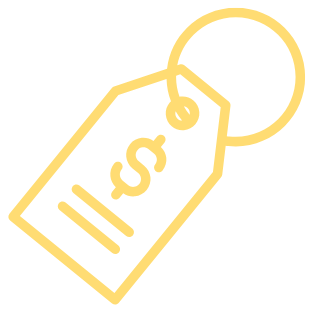
Before you search for buffer pedals, setting a realistic budget based on your specific needs and financial limitations is important.
This will help guide your decision-making process and prevent you from overspending or compromising on quality.
Remember that buffer pedals can vary greatly in price, ranging from affordable options for beginners to high-end, professional-grade models for accomplished musicians performing at the highest level.
To find the buffer pedal that best suits your needs, you must establish a budget range and use it as a reference point during your research.
This will help you identify and compare multiple options regarding sound quality and affordability.
By focusing on options that fall within your specified price range, you can ensure that you find the best buffer pedal for you without breaking the bank.
– Reviews and recommendations

In your quest to find the perfect buffer pedal, reading reviews from fellow musicians and seeking recommendations from trusted sources can provide valuable insight and help guide your decision.
Comparing various buffer pedal options, understanding their pros and cons, and taking into account the experiences of others will give you a better sense of which pedal will best suit your needs.
YouTube is an excellent place to do that:

It’s also essential to scrutinize these reviews and recommendations, as some may be biased or sponsored by a particular brand.
To avoid such biases, examine multiple sources and assess each buffer pedal’s overall reception before choosing.
How to properly use a buffer pedal?
We will explore properly using a buffer pedal to enhance your guitar tone and maintain signal quality throughout your signal chain.
By understanding the controls, adjusting the parameters, optimizing pedal placement, and employing various techniques, you can unlock the full potential of your buffer pedal and elevate your sonic experience.
– Familiarize yourself with the controls and features
To properly use a buffer pedal, first and foremost, you must understand its basic functions and features.
A buffer pedal is designed to preserve the quality of your guitar’s signal when treble content is lost due to long signal runs or multiple effects in the chain.
The pedal helps maintain the original signal strength and high-frequency response, maintaining your guitar’s tonal clarity and presence.
Begin by understanding the different controls on the buffer pedal.
Different buffer pedals may have a variety of knobs and switches, but most will have a few standard controls.
These may include input gain, output level, tone control, and a bypass switch for true bypass.
Some buffer pedals even include a built-in tuner or additional effects loops for further versatility.
– Adjust the parameters to suit your musical goals
Once you are familiar with the controls and features of your buffer pedal, it is time to adjust the settings to fit your specific musical needs.
If the pedal has an input gain control, you can use this to match the level of your guitar’s pickups.
If there is a tone control, play with it while listening to your guitar to find the ideal balance of treble and bass frequencies.
When adjusting the output level, keep in mind the goal of the buffer pedal.
It is to maintain signal strength, so aim for unity gain rather than boosting or cutting the signal too drastically.
After setting up your pedal to meet your desired tonal preferences, engage the bypass switch to see if there is a noticeable difference in sound quality when the pedal is active compared to when it is bypassed.
– Incorporate the buffer pedal into your signal chain
Placement is crucial in achieving optimal performance when incorporating a buffer pedal into your signal chain.
Generally, placing your buffer pedal at the beginning of your signal chain or as close to your guitar is best.
This ensures that the buffered signal is present throughout the entire chain, preventing any loss of signal strength.
However, experimentation is key to finding the ideal placement for your specific setup.
Try positioning the buffer pedal in different locations within your chain, testing its impact on your overall tone.
If you are using more than one buffer pedal, ensure that they are not placed too closely together, as this may result in over-buffering and negatively affect your signal level or distortion levels.
– Test the buffer pedal with your guitar and amp
Once you have set the controls and determined the optimal position for your buffer pedal in the signal chain, it’s time to test the results.
Connect your guitar to the pedal’s input and the output to your amplifier.
Turn on your amp and begin playing to evaluate the overall sound.

Pay attention to the specific aspects of your tone that can be improved with a buffer pedal – high-frequency clarity, presence, and articulation should be noticeably better when the pedal is engaged.
Switch the pedal on and off while playing to gauge the improvement in signal quality.
Also, consider testing the buffer pedal with different guitars and amplifiers to ensure that your desired tones can be achieved with multiple setups.
– Fine-tune the pedal settings based on your desired tone
Once you have experimented with your buffer pedal, it’s time to fine-tune the settings to reach your ideal tone.
If the pedal has adjustable knobs, such as input gain, output level, or tone control, play with these settings while listening intently to how they affect the final output.
Be sure to note the adjustments that bring you closer to the desired sound.
Remember that subtle changes can make a significant difference, so take the time to listen carefully and make small adjustments as necessary.
Remember that every setup is different, and changes may be needed when you use your buffer pedal with different guitars or amplifiers.
– Experiment with different playing techniques and effects for versatile usage
To maximize your buffer pedal’s potential, try experimenting with different playing techniques, such as fingerpicking, strumming, and tapping.
Each technique can elicit different responses from the pedal, leading to unique tones and textures that can add depth and variety to your sound.
Additionally, experiment with other effects pedals in conjunction with the buffer pedal.
Try placing overdrive, distortion, modulation, or delay pedals after the buffer to see how it affects the overall signal quality and tonal characteristics.
You may discover that the buffer pedal improves your clean tones and enhances the sound of your other effects.
– Regularly maintain your buffer pedal to ensure optimal performance
To keep your buffer pedal performing at its best, take the time to maintain it regularly.
Clean the pedal and its connectors using a soft, dry cloth to remove any dust or debris that may have accumulated.
If necessary, use contact cleaner on the jacks to help remove any oxidation that could impact signal quality.
Pay special attention to the battery if your pedal is powered by one.
Check the battery regularly and replace it as needed to prevent any loss of signal quality.
Additionally, ensure that the power supply used with the buffer pedal is clean and free from noise, which can also impact performance.
How to order pedals on a pedalboard?
There is no one-size-fits-all approach to ordering pedals on a pedalboard, as the optimal arrangement largely depends on the specific sound you’re aiming for.
Usually, though, you will see guitar players mostly agreeing with this order:
Tuner > Filters/Dynamics > Pitch-based Effects > Overdrive/Distortion > Modulation > Time-based Effects > Looper
Aside from that, some general guidelines can help you achieve a balanced and versatile setup.
Let’s talk in detail about the order we just mentioned, but feel free to experiment and adjust to your own preferences:
- Tuner: Place your tuner pedal first to ensure your signal is in tune before passing through the other pedals.
- Filters and dynamics: Wah-wah, envelope filters, compressors, EQs, and noise gates should come next. These pedals affect your sound’s dynamic and tonal aspects, so it’s best to place them early in the chain.
- Pitch-based effects: Octavers, harmonizers, and pitch shifters should come after filters and dynamics since these pedals alter the pitch of your signal and work best with a clean, unprocessed sound.
- Overdrive and distortion: Overdrive, distortion, and fuzz pedals typically come next. They shape your guitar’s core sound, and placing them before most other effects ensures that those effects receive a strong, consistent signal.
- Modulation effects: Chorus, flanger, phaser, and tremolo pedals should be placed after overdrive and distortion effects. We do this to allow these pedals to add depth and movement to your sound without becoming overly distorted or overbearing.
- Time-based effects: Delay and reverb pedals should be placed towards the end of your signal chain. This allows them to create a sense of space and depth around the other effects, simulating the sound of a room or hall.
- Looper: If you use a looper pedal, it should be placed last in the chain. This ensures that you’re looping the entire signal, including all the effects you’ve applied.
Remember, these are just general guidelines and what generally works and sounds good.
The most important thing is to experiment and find the arrangement that best suits your personal sound and style.
For example, here’s one pedalboard signal chain that I always use:
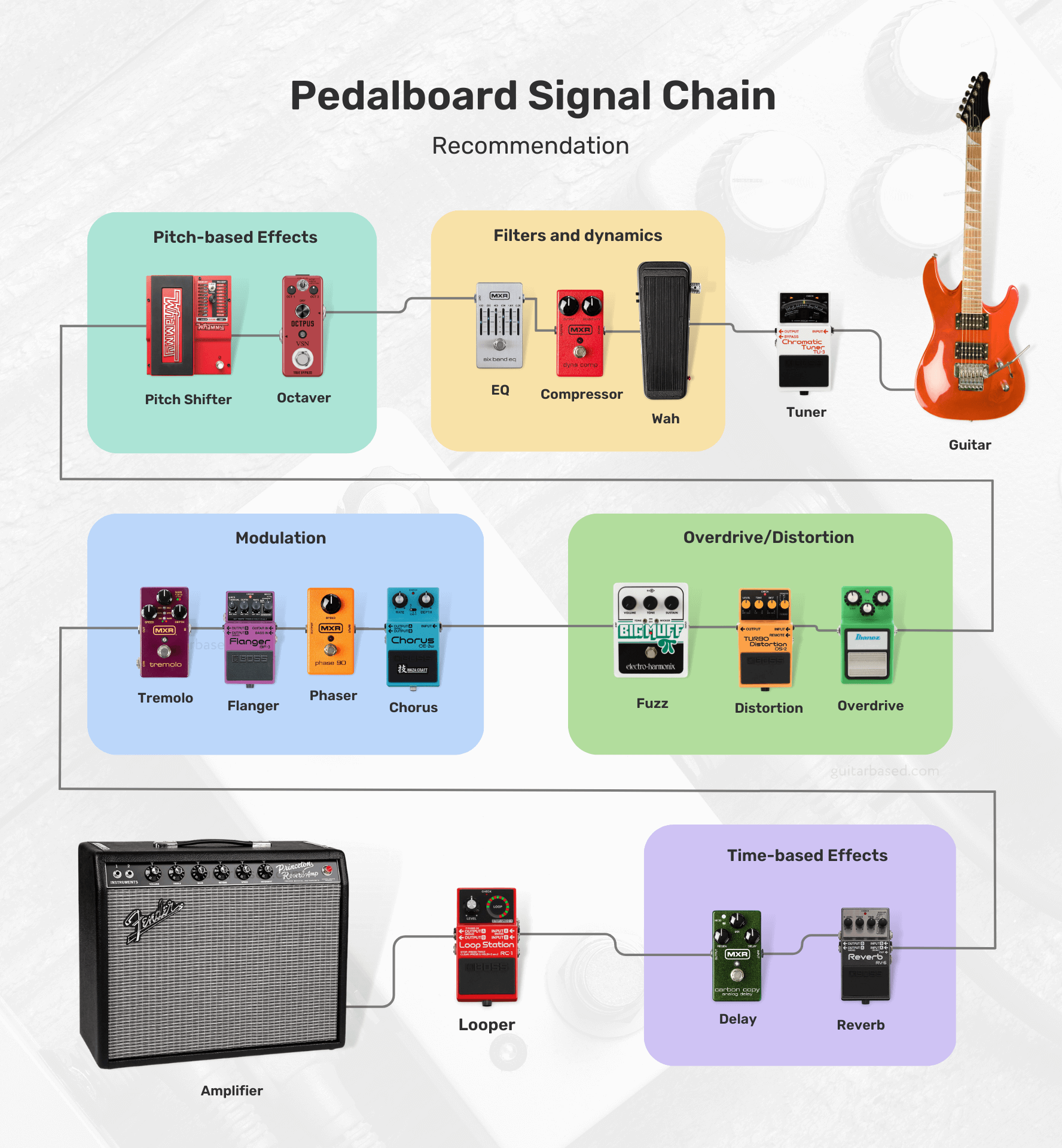
Feel free to swap the order of pedals, try different combinations, and test out unconventional setups until you find the one that works best for you.
For those interested, I’ll leave you with most of the possibilities that you’ll encounter and how to order them.
- Tuner
- Filters/Dynamics:
- Volume
- Wah
- Auto-Wah
- Compressor
- Noise Gate
- EQ (Equalizer)
- Pitch-based Effects:
- Octaver
- Harmonizer
- Pitch Shifter
- Overdrive/Distortion/Fuzz:
- Boost
- Overdrive
- Distortion
- Fuzz
- Modulation:
- Chorus
- Phaser
- Flanger
- Univibe
- Vibrato
- Tremolo
- Time-based Effects:
- Delay
- Echo
- Reverb
- Synth/Bitcrusher:
- Synth
- Bitcrusher
- Acoustic Simulator
- Multi-Effects
- Utility:
- Buffer
- A/B/Y Switcher
- MIDI Controllers
- Looper
Boutique vs. Mass-Produced pedals
Boutique pedals are generally built with higher-quality components and craftsmanship, resulting in better durability and longevity.
These pedals often feature unique and innovative designs, providing a wider range of tones and effects that may not be available in mass-produced options.
Here are a few examples of boutique pedals:

All the manufacturers also tend to have a more personal approach, with better customer service and the ability to customize pedals according to the user’s preferences.
However, boutique pedals are usually more expensive due to the smaller scale of production and the use of premium components.
Mass-produced pedals, on the other hand, are more affordable due to their larger scale of production and the use of cost-effective components.
These pedals are widely available and offer a range of popular effects, making them accessible to a larger audience.
Here are a few examples of mass-produced pedals:

The quality control for mass-produced pedals can vary depending on the brand and model, but many are reliable and offer good value for the money.
As for one of the downsides, you’ll find that mass-produced pedals may not have the same level of uniqueness or innovation as boutique options.
On the other hand, they may not provide the same level of customer service or customization options.
The choice between boutique and mass-produced pedals depends on your personal preferences, budget, and desired sound.
If you’re looking for unique tones, higher-quality components, and a more personal experience, boutique pedals may be the way to go.
But I would say, for those who are on a budget and need access to popular effects, mass-produced pedals might be a better fit.
It’s worth trying out both types to see which best suits your needs and playing style.
How much should you spend on a guitar pedal?
If I were in your position, I would first determine my budget and specific needs before deciding how much to spend on a guitar pedal.
For beginners, it might be more reasonable to start with affordable, mass-produced pedals to explore different effects without spending too much.
Guitar pedals can range in price from around $30 to over $400, depending on the brand, quality, and complexity of the effect.
As your skills and understanding of your preferred tone develop, you can gradually upgrade to higher-quality or boutique pedals.
One thing I would do is consider which effects are essential to your playing style and prioritize purchasing those first.
Allocating a larger portion of your budget to the most important pedals might be a wise choice, especially if you only need a few basic effects.
However, if you require a wide array of effects, you may want to consider more budget-friendly options or multi-effects units.
Keep in mind that higher-priced pedals often come with better build quality, unique features, and improved sound quality.
But I would also say that price is not always directly correlated with quality or suitability for your needs.
Sometimes, a more affordable pedal can deliver the exact sound you’re looking for, while a higher-priced option might not meet your expectations and are only expensive because of the brand reputation.
Can you use a guitar pedal with a bass guitar?
You can certainly use a guitar pedal with a bass guitar.
But it’s crucial to be aware that some guitar pedals may not be specifically designed to accommodate the frequency range of a bass guitar.
This could result in a less-than-ideal performance or an altered tone that might not be what you were expecting.
If you’re feeling adventurous and eager to experiment with your sound, don’t hesitate to connect your guitar pedals to your bass guitar.
This can be a fun way to explore different sonic possibilities, and you might even stumble upon some unique tones that complement your playing style perfectly.
Using a guitar pedal with a bass guitar may not always produce the desired results.
In some cases, the low-end frequencies might be lost, or the effect could sound too harsh or muddy.
To avoid these issues, you could consider looking into pedals that are specifically designed for bass guitars.
These pedals are engineered with the bass frequency range in mind, ensuring that your low-end remains intact and the effect sounds as intended.
In addition to bass-specific pedals, there are also multi-effects processors and pedals that cater to both guitar and bass players, offering a wide range of effects and tonal options.
These versatile units can be a great solution if you play both instruments and want a single device to cover your needs.
How to properly power your pedals?
When it comes to powering your pedals, you want to make sure you’re doing it right to avoid any noise issues or potential damage.
First, check each pedal’s power requirements, which you can usually find in the manual or on the pedal itself.
You’ll want to pay attention to the voltage (usually 9V, 12V, or 18V) and current (measured in milliamps or mA).
Now, you’ve got a few options for powering your pedals.
You can use individual power supplies or batteries for each pedal, but that can get messy and inconvenient.
I’d recommend going for a pedal power supply or an isolated power brick.

For example here are a few ones I recommend:
- Voodoo Lab Pedal Power 2 Plus Isolated Power Supply (My favorite)
- Rowin PW-1 Guitar Pedal Power Supply (Cheapest)
These babies can power multiple pedals at once, and the isolated outputs help prevent noise and ground loop issues.
Just make sure the power supply you choose can handle the voltage and current requirements of all your pedals.
When you’re connecting everything, use good quality power cables and keep them neat and tidy to avoid a tangled mess.
You might even want to use cable ties or cable organizers to keep everything in order.
In love with guitars, and gear; expert in all things music! Been writing about guitars for about 5 years and counting. Born in the ’90s. Alma Mater: University of Havana. Always curious, trying to understand the world. #TeamFender

